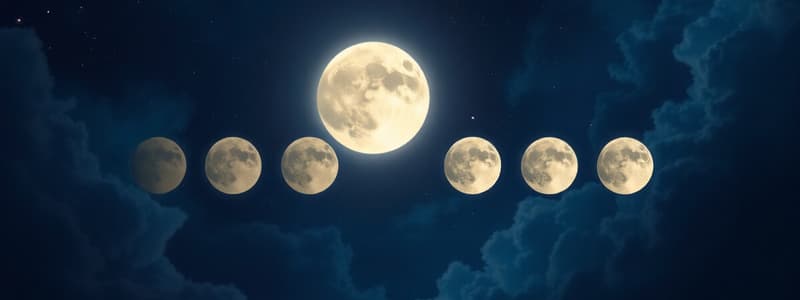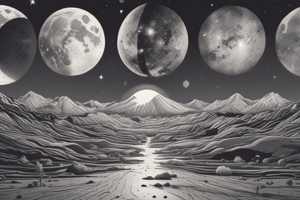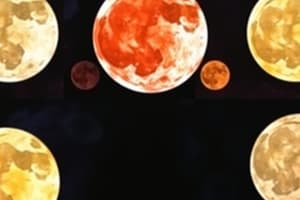Podcast
Questions and Answers
What is the primary source of light that makes the moon visible from Earth?
What is the primary source of light that makes the moon visible from Earth?
- The moon's own internal nuclear reactions
- Sunlight reflected off the moon's surface (correct)
- Light emitted by the Earth's atmosphere
- Light from distant stars, focused by the moon's gravity
Why does the appearance of the Moon change throughout the month?
Why does the appearance of the Moon change throughout the month?
- Clouds and weather patterns on Earth obscure parts of the moon's surface.
- The moon emits varying amounts of light during its rotation.
- Our viewing angle of the illuminated portion of the moon changes as it orbits Earth. (correct)
- The moon changes its physical shape due to gravitational forces.
During which lunar phase is the Moon not visible from Earth?
During which lunar phase is the Moon not visible from Earth?
- New Moon (correct)
- First Quarter
- Waning Crescent
- Full Moon
What term describes the phases of the moon when the illuminated portion is increasing?
What term describes the phases of the moon when the illuminated portion is increasing?
Which phase comes immediately after the first quarter moon?
Which phase comes immediately after the first quarter moon?
Which statement best describes the 'waning gibbous' phase?
Which statement best describes the 'waning gibbous' phase?
Approximately how long does it take for the Moon to complete one full orbit around the Earth?
Approximately how long does it take for the Moon to complete one full orbit around the Earth?
Why is the time between two new moons (29.5 days) longer than the Moon's orbital period (27.3 days)?
Why is the time between two new moons (29.5 days) longer than the Moon's orbital period (27.3 days)?
In the Northern Hemisphere, when do you see the waxing crescent phase?
In the Northern Hemisphere, when do you see the waxing crescent phase?
Which of the following best describes the third quarter moon?
Which of the following best describes the third quarter moon?
A student observes a moon that is more than half but not fully illuminated, and the illuminated part is decreasing. Which phase is the moon in?
A student observes a moon that is more than half but not fully illuminated, and the illuminated part is decreasing. Which phase is the moon in?
If tonight the moon is in its first quarter phase, approximately how long from now will it be in its full phase?
If tonight the moon is in its first quarter phase, approximately how long from now will it be in its full phase?
Which sequence correctly orders the lunar phases, starting from the new moon?
Which sequence correctly orders the lunar phases, starting from the new moon?
Imagine you are observing the moon and see a phase where it appears as a thin crescent of light on the left side. What phase are you observing, and what part of the world are you in?
Imagine you are observing the moon and see a phase where it appears as a thin crescent of light on the left side. What phase are you observing, and what part of the world are you in?
How would the appearance of the moon change if the Earth did not orbit the sun?
How would the appearance of the moon change if the Earth did not orbit the sun?
When does the Waning Crescent phase occur?
When does the Waning Crescent phase occur?
You observe that the moon is more than half illuminated, and the illuminated portion is increasing each night. Which phase are you observing?
You observe that the moon is more than half illuminated, and the illuminated portion is increasing each night. Which phase are you observing?
The first quarter moon is often referred to as a half moon. In relation to the sun, where is the location of the moon during this phase?
The first quarter moon is often referred to as a half moon. In relation to the sun, where is the location of the moon during this phase?
If the average time from new moon to new moon is about 29.5 days, approximately how many days after a full moon will the next new moon occur?
If the average time from new moon to new moon is about 29.5 days, approximately how many days after a full moon will the next new moon occur?
During which moon phase can the moon not be seen at all from earth?
During which moon phase can the moon not be seen at all from earth?
Flashcards
What is moonlight?
What is moonlight?
Sunlight reflected off the Moon's grayish-white surface.
What are Moon phases?
What are Moon phases?
The different shapes of the Moon we see at different times of the month.
What causes lunar phases?
What causes lunar phases?
The Moon orbits Earth, and Earth orbits the Sun.
What is a New Moon?
What is a New Moon?
Signup and view all the flashcards
What is a Waxing Crescent?
What is a Waxing Crescent?
Signup and view all the flashcards
What is the First Quarter?
What is the First Quarter?
Signup and view all the flashcards
What is Waxing Gibbous?
What is Waxing Gibbous?
Signup and view all the flashcards
What is a Full Moon?
What is a Full Moon?
Signup and view all the flashcards
What is Waning Gibbous?
What is Waning Gibbous?
Signup and view all the flashcards
What is the Third Quarter?
What is the Third Quarter?
Signup and view all the flashcards
What is Waning Crescent?
What is Waning Crescent?
Signup and view all the flashcards
How long to orbit?
How long to orbit?
Signup and view all the flashcards
How long from new moon to new moon?
How long from new moon to new moon?
Signup and view all the flashcards
Study Notes
- Earth observes moonlight, which is sunlight reflecting from the Moon's grayish-white surface.
- The Moon would be entirely dark without the Sun.
- The quantity of the illuminated Moon visible varies monthly due to lunar phases.
- Lunar phases occur since the Moon orbits Earth, and Earth orbits the Sun.
- The moon's appearance changes each night.
- This change is viewed differently from Earth depending on its orbit around our planet.
- The Moon cycles through eight phases monthly, taking 27.3 days to orbit Earth.
- Sunlight and its reflection take 29.5 days to go from one new moon to the next.
Moon Phases
- New: The Moon is not visible during this phase.
- Waxing Crescent: In the Northern Hemisphere, it appears as a thin crescent with light on the right side.
- First Quarter: The Moon appears as a half moon.
- Waxing Gibbous: This phase occurs between a half-moon and a full moon; "waxing" signifies it's growing.
- Full: The entire Moon is illuminated fully during this phase.
- Waning Gibbous: This phase is between a full moon and a half-moon; "waning" means it's getting smaller.
- Third Quarter: The Moon again appears as a half moon, but the opposite half is illuminated compared to the first quarter.
- Waning Crescent: In the Northern Hemisphere, it appears as a thin crescent with light on the left side.
Studying That Suits You
Use AI to generate personalized quizzes and flashcards to suit your learning preferences.




